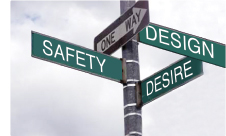
| Tracking Trends | |
| Finding Balance | |
| Collision Education | |
| All Parts Included | |
 |
| Finding Balance. Where vehicle design, saftey and consumer desire intersect |
 By Chrisa Hickey By Chrisa Hickey |
It seems that since the inception of the automobile, it’s been a challenge to find the practical intersection between what consumers want, what manufacturers can produce and what repair facilities can fix. And as autos change over time, two other factors enter into this equation: technology and safety. They seemingly belong together, as numerous safety measures are made possible through the advancement of technology. The element of safety carries extra weight in the design and construction process, since it isn’t so much a consumer desire as it is a construction mandate. Take, for example, the National Highway Traffic Safety Administration (NHTSA)’s Federal Motor Vehicle Safety Standards. In October of 2004, NHTSA conducted an analysis of how many lives have been saved with the implementation of all mandatory auto safety devices (e.g., air bags, energy-absorbing steering assemblies, safety belts) falling under the auspices of its federal standards rule. Results show that an estimated 328,551 lives have been saved from 1960 to 2002 (total duration of research). On the construction side, manufacturers face the two-fold challenge of incorporating safety technology while remaining cost-competitive. Vehicles not only need to meet certain safety standards, but they have to offer up a diverse enough product line to meet the desires of the buyer—two big drivers in the marketplace. On the face of the issue, it would seem that repairability would be the element to get less attention. According to one manufacturer, however, it remains toward the top of the list. This article takes a look at how these elements are progressing and what may be on the horizon. Standing on a Platform General Motors used a common platform in the 1960s with cars such as the Buick Skylark, Oldsmobile Cutlass and Chevrolet Chevelle, altering only the sheet metal to create styling variations. According to Dennis Virag, President of The Automotive Consulting Group, “The industry then got away from common platforms because the perception was that each vehicle had to be different and unique and couldn’t share components.” However, Japanese automakers brought back the idea in the 1990s. “The Japanese really began the new wave of platform commonality. It’s more economical to build many vehicles on a common platform and have shared components. The Big Three saw the Japanese doing it with success, and went back to sharing themselves.” Scott Margason, National Manager of Model Line Planning at Hyundai Motor America, said it’s become an extremely effective manufacturing process for two reasons: it lets them remain cost-competitive in the marketplace while offering up enough different vehicle designs to meet the wants of choice-hungry consumers. “Hyundai does use common platforms for several different vehicles. We currently have three major platforms for seven models,” said Margason. “As the market moves to more models at lower volumes—the ‘atomization’ of the market—we expect that it will continue to be important to share platforms in the future.” Hyundai believes this so much that their new $1.1 billion, two million square foot facility in Montgomery, Alabama has built design elements to aid the process. “The plant was not designed to weld just one body, but several different vehicles of different sizes,” added Margason. “Plants today are developed with that flexibility in mind. At the Montgomery facility, we can build four different vehicles on the line at the same time.” Susanna Gotsch, CCC’s Director for Reporting and Analysis, agrees with Margason’s assessment of marketing atomization, adding that, “It used to be that a manufacturer could make one million of a single type of vehicle. But because consumer preferences change very quickly, platform sharing provides them the possibility to make changes with minimal retooling. Instead of 1 million of one type of vehicle, manufacturers can now as efficiently make 250,000 each of four different models.” The numbers are proving this to be true: In 1993, there were 216 makes and models from which to choose. That number is projected to balloon to 316 different offerings by 2008. Evolution, Proliferation of Technology
Jason Bartanen, Technical Development Manager at I-CAR, said there’s a need for more training and information sharing. “Technicians may not be aware of how much information is available, and where to get it. All technicians aren’t well-versed in the Internet, so some may not know that the OEMs service information Web sites exist because the computer is in the front office and they’re out on the shop floor.” In addition to OEM service information Web sites, Virag said there’s a growing need for new repair equipment to meet the constant vehicle design changes. “Technicians will need special tools and training to test the functionality of electronic systems,” he said. “With on-board electronics, various systems are interfacing with each other. Those will have to be tested to make sure the systems are functioning properly. There must be clear communication to ensure that systems are repaired properly and functioning when cars go back on the road.” Hyundai’s Margason knows that this is a concern, especially with the numerous model offerings. “Of course when you have a common platform that’s being used for both a sedan and a smaller sport utility vehicle, there’s a substantial amount of modification that goes on,” said Margason. “But when we have vehicles sharing a platform like the Tuscon and the Elantra, the basic components and layouts are very familiar—things like suspension pieces and safety equipment.” Adds Margason: “Certainly there’s more complexity, with the safety systems and electronics. But the more of those you can share, the better it is. We’re constantly looking at factors, like having a limited number of suppliers providing familiar parts across all model line, such as safety devices, which is an aid to the repairer because it’s a familiar part.” Total Loss Impact These shifts in technology are also changing the way insurers write policies, said Gotsch. “There used to be a lot of insurers who would write policies or determine costs by a number of factors: the driver’s age, sex, their driving history, miles per year. Insurers also used categories of vehicles,” Gotsch said. “Insurers now are trying to price to specific models. There are certain insurers that do a lot of very specific pricing based on vehicle characteristics.” Gotsch added that platform sharing could be one aspect to help address the total loss issue. “One of the thoughts is that when more vehicles share a platform, there will be a greater availability of alternate parts,” she said. “There’s also a thought that similar platforms allow technicians to port experience from one vehicle to another in a cost-effective manner. This is the intent.” That intent is reflected in Hyundai’s position that common parts and platforms will help on the training end of things. Future Challenges? “With so few models using the technology right now, I see aluminum more as a production experiment,” said Virag. “This way they can learn how to improve it and take the cost out of it.” Although Virag recognizes the benefits and potential of aluminum, he also feels steel retains certain marketplace advantages. “Steel has done a terrific job combining light weight with high strength, and it has significant cost advantages over aluminum. From a durability standpoint, aluminum vehicles typically are more likely to be totaled because of their high repair cost.” According to Hyundai and Margason, he doesn’t see them shifting to aluminum in the near future. Our position,” he said, “is that the technologies like aluminum are still too cost prohibitive.” With the automotive marketplace in a constant state of change, it’s been hard to identify the “next big thing” to impact the industry. With varying consumer desires and the need for quality repairs seemingly a constant, the ability to keep an active, open line of communication between governing bodies, manufacturers, repairers and insurers will remain critical to realizing all of the benefits that vehicle design and safety-related technologies has to offer. Chrisa Hickey is Director of Project Management at CCC Information Services Inc. |
 “To maximize the benefits of the new body styles, hybrid vehicles and electronics components being used in today’s vehicle, manufacturers need to continue to provide updated repair data to the body shops,” said Gotsch. “Equally important to creating a safer, more technically advanced vehicle off of floor, is ensuring the repairability of the vehicle after it has been in an accident.”
“To maximize the benefits of the new body styles, hybrid vehicles and electronics components being used in today’s vehicle, manufacturers need to continue to provide updated repair data to the body shops,” said Gotsch. “Equally important to creating a safer, more technically advanced vehicle off of floor, is ensuring the repairability of the vehicle after it has been in an accident.”